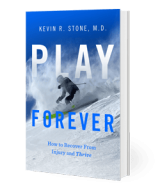Becoming a More Evolved Patient in 2022 (excerpt from Play Forever book)
Surgical procedures have advanced in leaps and bounds over the last decade, but patients like you are evolving, as well. It’s now widely recognized that for a surgery to be truly successful, a patient must become a more active participant in controlling surgical outcomes. Here’s how you can begin your journey as a more evolved patient.
This article is an excerpt from Dr. Stone's book Play Forever.
Well before your surgery date. Exhaust all the alternatives to total knee replacement first. Depending on your exam, X-rays, and MRI, these alternatives may include physical therapy with gait, balance and muscle training, biologic joint replacement procedures with meniscus replacement, articular cartilage repair, or partial joint replacement if only one or two portions of the knee are worn out. Partial knee replacements work much better than in the past due to computer and robotic insertion techniques that have taken inaccuracy out of the procedure.
Envision a new you. Look at your procedure as an opportunity to become fitter, faster, and stronger than you have been in years. This is not usually possible when you are in pain, but it is a great goal to have once the discomfort is gone. Looking forward to “you, only better” makes the experience much less worrisome and turns it into a positive event in your life.
Before surgery. Line up a physical therapist, a trainer, a massage therapist, and a nutritionist. Yes, all of them, if possible. Use presurgery physical therapy and massage to increase range of motion and develop exercise routines focused on trunk and core strengthening.
See a nutritionist to help ensure that your dietary intake of protein is sufficient to respond to the stress of surgery. Protein matters. There is solid data that a low albumin level (protein level in the blood) correlates with increased infection during and after surgery. Also, optimizing your weight before and after surgery helps you preserve your new joint.
The night before your procedure, be entertained. Go out and see a movie, or watch a comedy series at home. Relax, laugh, and sleep well.
The day of surgery. Smile. Having a confident, calm, positive attitude affects you and your surgical team. Upbeat comments translate into happy outcomes. The advice of my former nurse and surgical assistant, Ann Walgenbach, is to just “let it go” (as in the song). Be confident that you are in safe hands. You’re going to have a really good nap, and in a few minutes, you’ll have a new knee. If you are anxious, consider listening to a guided meditation or music (some surgery centers will allow you to listen in the operating room). If you are particularly anxious, talk to your surgical team about whether you can take a medication such as Valium in the morning with a sip of water.
After surgery. Set aside time to focus on physical therapy—the day after surgery and every day. A great physical therapist will help work on the entire body, restoring the ability of parts to work together. Take enough time off work to get into the physical therapy clinic as often as possible in the first six weeks. While some surgeons don’t believe physical therapy helps, we are adamantly in the opposite camp.
Some physical therapists will focus on training and fitness, but others may not have the time or insurance permission to do so. Consider seeing a fitness trainer at a gym or hiring one to come to your home. It’s often less expensive and feels less like medical treatment. Post-surgery, it is important to see yourself as an athlete in training rather than a patient in rehab. Focus on building muscle strength in your upper body, trunk, and core as well as the lower extremities. Bike and pool exercises cannot be overdone.
Book regular massages. A massage therapist can often augment the work the physical therapist does and keep your tissues flexible while your joint heals and your body retrains. Treat yourself as any pro athlete would; use all the tools of the fitness trade. If you are thinking that only rich people or privately insured people can follow this advice, think again. Physical therapy is usually covered for at least a few sessions. Gym trainers and fitness classes can be found for less than twenty dollars an hour. Self-massage works too. Nutrition advice is widely available online. Focus on increasing protein and water intake, decreasing carbohydrates, and exercising more than you eat. Be more active, more aware, and more focused on your recovery, while working toward staying positive and visualizing the goal you’re working toward—all of this helps in allowing you to get back on your feet and be better than you have been in years. Whether your sport is skiing or simply walking in the mall, our goal is to help you do these actively and without pain so that you can drop dead at age one hundred while enjoying your sport. To do that, seeing yourself as an athlete in training and treating yourself as the pros do is the trick.
To learn more about how to become an active participant in your recovery, check out Dr. Stone’s new book Play Forever: How to Recover from Injury and Thrive, on Amazon now. Here's his recent appearance on Good Morning America sharing the value of sleep to your athletic recovery.


